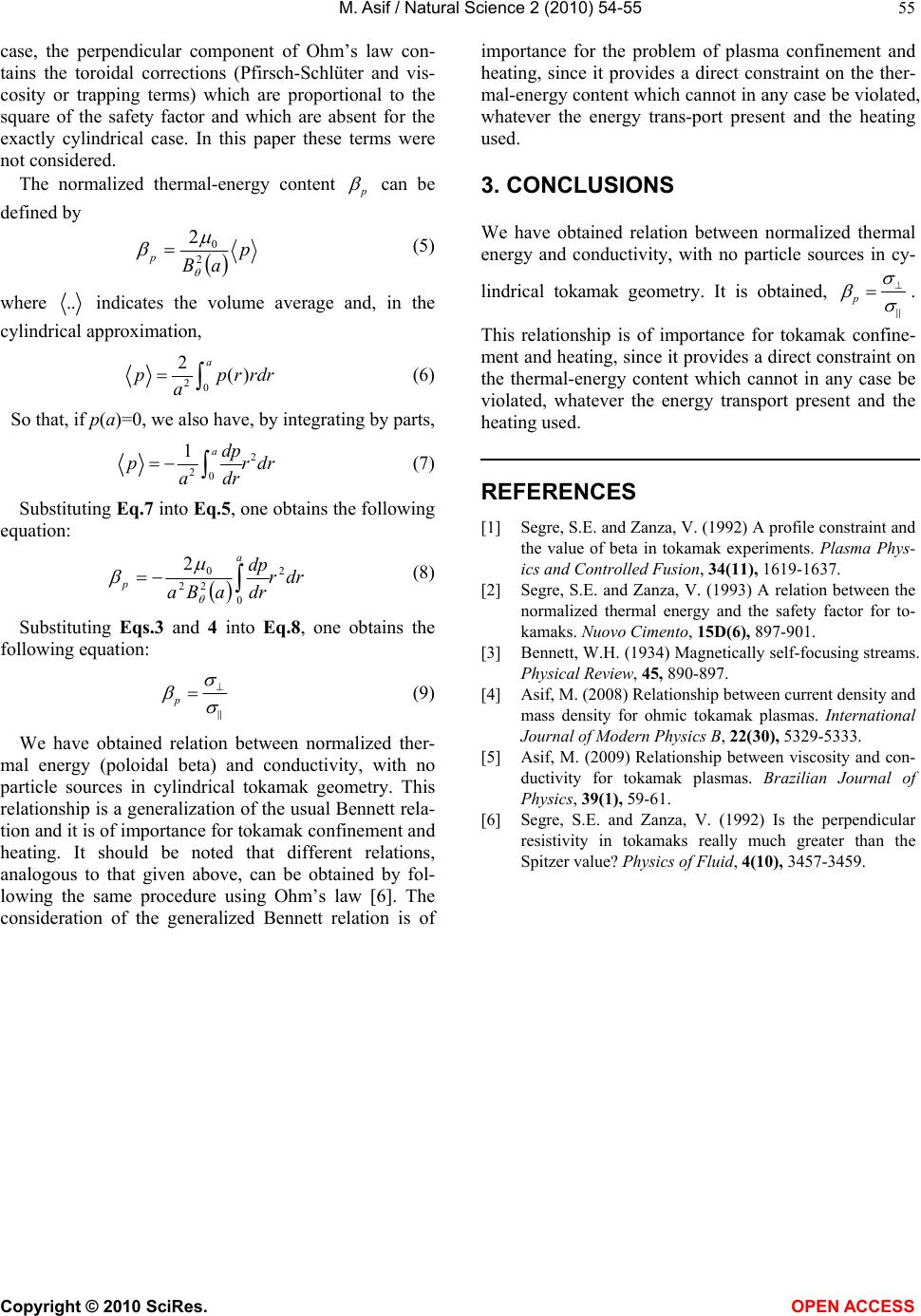Paper Menu >>
Journal Menu >>
 Vol.2, No.1, 54-55 (2010) Natural Science http://dx.doi.org/10.4236/ns.2010.21008 Copyright © 2010 SciRes. OPEN ACCESS Relationship between normalized thermal energy and conductivity for cylindrical tokamak geometry M. Asif Department of Physics, COMSATS Institute of Information Technology, Lahore, Pakistan Received 23 November 2009; revised 4 December 2009; accepted 7 December 2009. ABSTRACT The relation between normalized thermal en- ergy and conductivity, with no particle sources in cylindrical tokamak geometry has been de- rived. It is obtained, p . This relationship is of importance for tokamak confinement and heating. Keywords: Thermal Energy; Cylindrical Geometry; Confinement 1. INTRODUCTION It was previously shown [1], using a numerical analysis, that from the poloidal and toroidal components of Ohm’s law for a tokamak, there follows a relation between the normalized thermal-energy content, β, and the normal- ized plasma current, 1/q, which only depends on the plasma refueling and not on thermal-energy transport. Previously, the relation was examined only numerically and it is the purpose of [2] to provide an approximate analytical expression for this relation valid for tokamaks, showing explicitly the dependence on the fueling pa- rameters. The relation [3] implies a constraint on the thermal-energy content which cannot be violated, what- ever the energy transport present and the plasma heating used. It should be noted that a different relation [4,5] has been derived. Analogous to that of above models, can be obtained by following the same procedure but using Ohm’s law [6]. The main focus of this paper is to show the relation between normalized thermal energy and conductivity, with no particle sources in cylindrical tokamak geometry. It is obtained, p . This rela- tionship is of importance for tokamak confinement and heating, since it provides a direct constraint on the ther- mal-energy content which cannot in any case be violated, whatever the energy transport presents. 2. RELATION BETWEEN NORMALIZED THERMAL ENERGY AND CONDUCTIVITY We consider the problem of determining the steady state in cylindrical tokamak geometry with no particle sources. First of all, we recall the expressions for the toroidal and poloidal components of Ohm’s law, which can be put in the following form [6], with no particle sources in the limit of large aspect ratio and circular magnetic surfaces: E j (1) dp EB dr (2) where all quantities are surface-averaged and depend on the minor radius r, J is the toroidal component of the current density, E is the electric field, and is the parallel and perpendicular resistivities, B and B are the toroidal and poloidal components of the magnetic field, p is the plasma pressure. The safety fac- tor is q=rB /R B and R is the major radius. The minor radius of the last closed magnetic surface will be indi- cated by a, and B and J are related by Ampere’s law dr rBd r j 0 1 (3) Substituting Eq.1 into Eq.2, one obtains the following equation: Bj dr dp (4) It should be stressed that, in comparing tokamak ex- periments with theory, one can certainly use the cylin- drical approximation where all quantities depend only on minor radius r; however, one must then consider the relations between surface-averaged quantities. In this  M. Asif / Natural Science 2 (2010) 54-55 55 Copyright © 2010 SciRes. OPEN ACCESS case, the perpendicular component of Ohm’s law con- tains the toroidal corrections (Pfirsch-Schlüter and vis- cosity or trapping terms) which are proportional to the square of the safety factor and which are absent for the exactly cylindrical case. In this paper these terms were not considered. The normalized thermal-energy content p can be defined by p aB p2 0 2 (5) where .. indicates the volume average and, in the cylindrical approximation, 20 2() a pprrdr a (6) So that, if p(a)=0, we also have, by integrating by parts, 2 20 1adp prdr dra (7) Substituting Eq.7 into Eq.5, one obtains the following equation: drr dr dp aBa a p 2 0 22 0 2 (8) Substituting Eqs.3 and 4 into Eq.8, one obtains the following equation: p (9) We have obtained relation between normalized ther- mal energy (poloidal beta) and conductivity, with no particle sources in cylindrical tokamak geometry. This relationship is a generalization of the usual Bennett rela- tion and it is of importance for tokamak confinement and heating. It should be noted that different relations, analogous to that given above, can be obtained by fol- lowing the same procedure using Ohm’s law [6]. The consideration of the generalized Bennett relation is of importance for the problem of plasma confinement and heating, since it provides a direct constraint on the ther- mal-energy content which cannot in any case be violated, whatever the energy trans-port present and the heating used. 3. CONCLUSIONS We have obtained relation between normalized thermal energy and conductivity, with no particle sources in cy- lindrical tokamak geometry. It is obtained, p . This relationship is of importance for tokamak confine- ment and heating, since it provides a direct constraint on the thermal-energy content which cannot in any case be violated, whatever the energy transport present and the heating used. REFERENCES [1] Segre, S.E. and Zanza, V. (1992) A profile constraint and the value of beta in tokamak experiments. Plasma Phys- ics and Controlled Fusion, 34(11), 1619-1637. [2] Segre, S.E. and Zanza, V. (1993) A relation between the normalized thermal energy and the safety factor for to- kamaks. Nuovo Cimento, 15D(6), 897-901. [3] Bennett, W.H. (1934) Magnetically self-focusing streams. Physical Review, 45, 890-897. [4] Asif, M. (2008) Relationship between current density and mass density for ohmic tokamak plasmas. International Journal of Modern Physics B, 22(30), 5329-5333. [5] Asif, M. (2009) Relationship between viscosity and con- ductivity for tokamak plasmas. Brazilian Journal of Physics, 39(1), 59-61. [6] Segre, S.E. and Zanza, V. (1992) Is the perpendicular resistivity in tokamaks really much greater than the Spitzer value? Physics of Fluid, 4(10), 3457-3459. |

